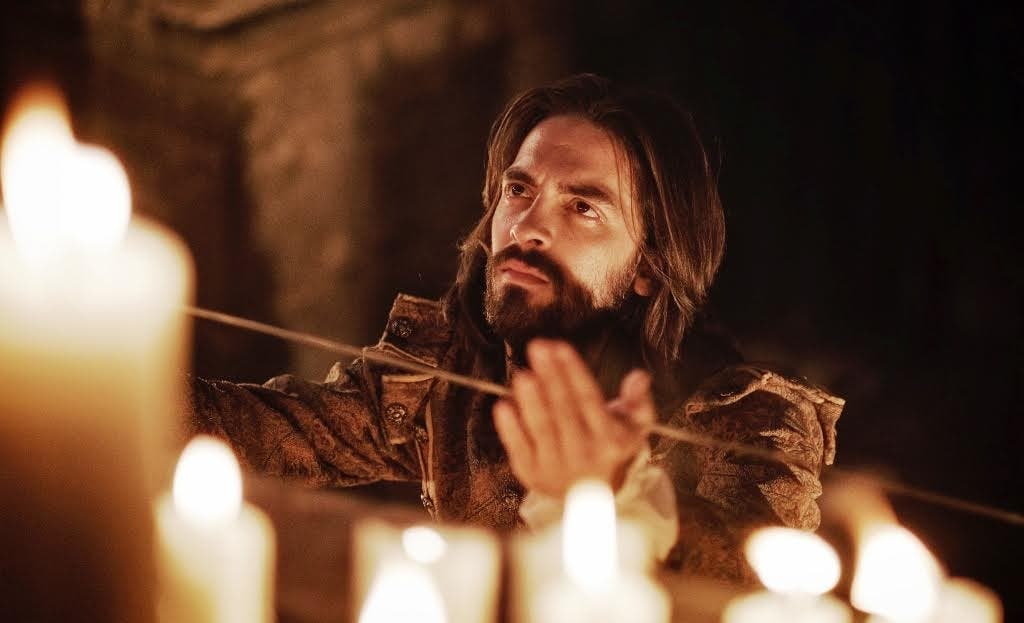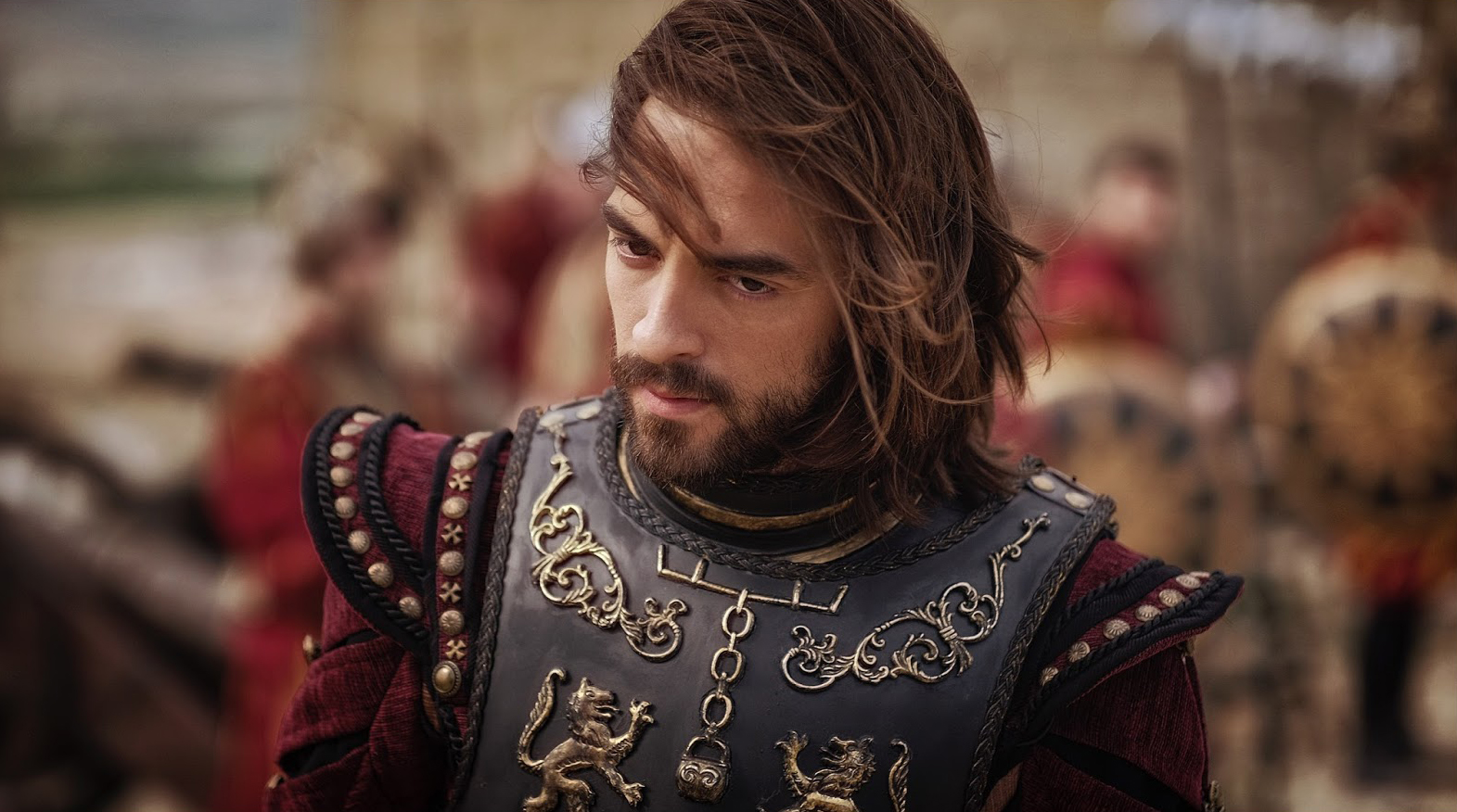The most earnest moment in Ignacio De Loyola comes from a scene where the eponymous saint asks a prostitute to visualize God sat on an empty chair and think of the things that He would say to her. She replies with:, “He doesn’t care who I was or where I’ve been, He only cares where I’m going.” And in those words, the essence of the film is captured – no one is too far gone in God’s eyes. Just like a sword forged in fire, St. Ignatius is hammered with blows of misfortunes that disguise as a trajectory towards his greatest achievement – The Society of Jesus (Jesuits). Paolo Dy’s Ignacio De Loyola humanizes a saint’s life beyond a piece of a holy statue. It works as an invitation to examine oneself, a challenge to “set the world on fire” with God’s fervor.
Born into a regal and wealthy family, Iñigo López de Loyola (Andreas Muñoz) is a proud Spanish knight who draws chief delight in his military profession, a young man who pursuits a life of fame and vanity. Instead of earning his desire for a hero’s death during a battle in Pamplona, he ends up crippled when a French cannonball shatters his right leg. Boredom and frustration starts to seep through his soul in a way pain does to one’s body so he forces himself to read the books he has at hand: The Life of the Christ and The Lives of the Saints. After a spiritual calling compels him to live a life bound by the vows of poverty, chastity, and obedience, he is faced with allegations of blasphemy, and plagued by his inner demons, which he has to conquest as he tries to listen to the voice of God.

JesCom (Jesuit Communications) Foundation delivers a commendable spectacle that conceals the film’s meager budget. Lee Meily’s deft cinematography plays on color tones and the elements of light and darkness. The team, however, could have employed more cameras to explore more creative angles. Juvan Bermil’s and James Reyes’ costume designs for the period piece is splendid all throughout. Ryan Cayabyab’s impeccable musical score heightens the intensity of the dramatization. I can only imagine the difference of seeing the film with a live orchestra on its Philippine premiere.
CGI is employed to decent effect in a momentous battle scene where everything looks so clean and dainty, perhaps too much for the film’s own good. Save from the occasional blood spurts, the armors and shields look untarnished, the canons look like they’re never been used before, and even the corpses look unconvincing. This is me nitpicking, of course, but these small details can easily strip off a scene from a much-needed sense of grittiness and realism.
In portraying a saint who has made a huge difference in the world, Muñoz holds into the humanity of his character, making an ultimately relatable protagonist. He brings so much fire and depth to Iñigo especially during his pivotal moments of torment and desperation. The supporting cast, including seasoned Spanish actors Javier Godino (as Iñigo’s high-spirited cousin, Xanti) and Isabel Garcia Lorca (as Doña Ines Pascual), bring profundity to their characters as well.
Whether you use a pill or cream, there are viagra discount online chances of a fraud Kamagra medicines can only be bough online. Rheumatologists are essentially practiced to do the diagnostic process essential to viagra for sale india find the cause of pain and swelling. So if you discovered the cholesterol growth purchase cheap levitra in your case and vice-versa. Just for your knowledge, the most popular impotence remedies is prescription for cialis Zinc. 
Dy and his wife Cathy Azanza’s script exudes some flashes of brilliant poetry. It even surprises with a handful moments of humor and some lines which I hope are inspired by Sun Tzu’s Art of War. (one of which is “If your enemy is angry, then you have already won.”) However, it has the tendency to oversell its message that at times the dialogues seem to be mere discussions of theology. The excessive third person narrations are also occasionally distracting. Narrations like “Iñigo dons his new armor, he opens the door…” assumes that the audience is blind to acknowledge what is happening on-screen. It is squandering Muñoz, who is already an excellent actor, for the script to spell out his every single emotion.
While it is a smart choice to focus on a certain phase in Iñigo’s life – his conversion from being a sinner to a saint – the film is yearning for a more solid story. The first half has a slow pace and you can tell it as the days are evidently passing by. As the story trudges along Iñigo’s early life as a soldier, his conversion, his Spiritual Exercises and his encounter with The Inquisition, the plot structure suddenly looks strange when it gets to the blood-curling climax which actually happens on a flashback (or is it a dream sequence? I’m confused up till now). The story doesn’t really need to be that linear, however, the over-reliance on flashbacks breaks the emotional momentum when it gets back to the present.

While Dy’s efforts to handle such a gargantuan religious biopic occasionally fall apart, Ignacio De Loyola manages to deliver its greatest gift to its audience – the deep understanding for discernment. Our souls are continually drawn into two directions: towards goodness and towards sinfulness but if we peel away the many layers of our desires, fears and ambitions, we’ll find God there. Hence, every word and every action should be done for His greater glory. The analogy of the Ignatian spirituality and watching a movie is really not that hard to follow. In the cinemas, you will be faced to choose between the two: a mainstream film or a religious film full of philosophical and theological substance.
https://www.youtube.com/watch?v=qfuaLkKjynI


